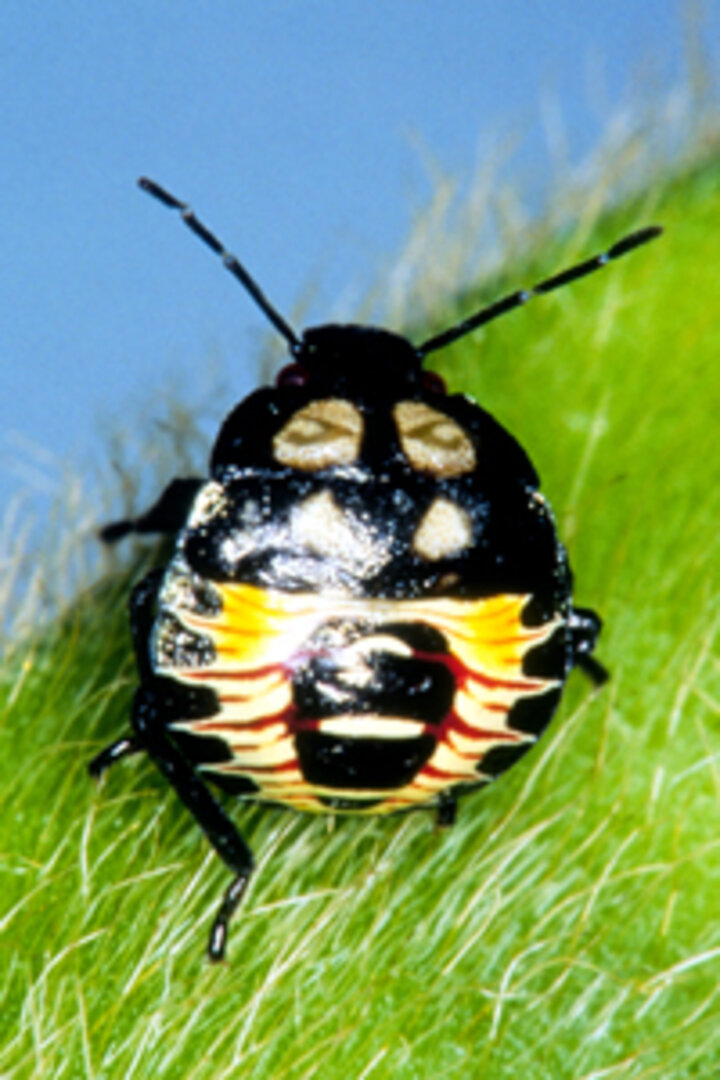July 25, 2008
Reports of stink bugs in Nebraska corn and soybean have been increasing the last few years. In the past, stink bugs have not been considered a significant pest of corn or soybean in Nebraska, but they are an economic pest to a variety of crops in the southern United States. There seems to be a general trend of increasing stink bug populations in more northern states, and in 2007 there were reports of significant injury to field corn in Nebraska.

|
(Left) Green stink bug nymph; (below) Brown stink bug (Photos by Jim Kalisch) |

|
|
The major stink bug species found in Nebraska corn and/or soybeans are the green stink bug, Acrosternum hilare, the brown stink bug, Euschistus servis, and the one-spotted stink bug, Euschistus variolarius. In general, adult green stink bugs are bright green, and adult brown stink bugs are brown with a yellow or light green underside. Green stink bug nymphs change color and pattern as they grow, but brown stink bug nymphs are yellow to tan with brown spots down the center of the abdomen. The one-spotted stink bug looks similar to the brown stink bug, except it has a small spot on the underside of the abdomen. Another brown stink bug, the spined soldier bug, Podisus maculiventris, is a beneficial predatory insect.
General Stink Bug Biology
Adult stink bugs overwinter primarily in leaf litter, under bark, or in wood piles. It is believed that the green stink bug migrates north. Brown and one-spotted stinkbugs appear to overwinter in Nebraska.
In the spring, adult stink bugs leave their overwintering sites and feed on a variety of wild and cultivated hosts. After feeding a few days, they mate and lay clusters of eggs. As the season progresses, female stink bugs are attracted to a variety of flowering plants, including corn and soybean. There are likely one to two generations in Nebraska, depending on species.
Stink Bug Injury to Corn and Soybean
Stink bugs have piercing and sucking mouthparts and feed by piercing a plant part (or another insect in the case of the spined soldier bug), injecting digestive enzymes, and removing fluids.
Corn. Nymphs and adult stink bugs injure reproductive stage corn by piercing the husk and feeding on the developing kernels from the beginning of kernel formation through milk stage, although the can feed through the hard dough stage. Damage appears as missing or shrunken kernels. Severe damage causes ears to curve (banana ears). (See the June 6 CropWatch No.08-13 for information on stink bug in seedling corn.)
Soybean. Nymphs and adult stink bugs injure soybeans by puncturing various soybean plant parts and extracting plant fluids. They prefer young tender growth and developing seeds. As they feed they inject digestive enzymes, which cause deformation and abortion of seeds and pods, and predispose the feeding site to various pathogens. In addition, stink bugs can cause delayed maturity and deformed leaf growth. Yield and quality losses depend on when the bugs injure soybean, and can be severe.
Occurrence. Injury often appears first on field borders as the stink bugs move into the field (both corn and soybean fields). With time the stink bugs can move throughout the field.
Management of Stink Bug in Corn and Soybean
Little research or experience with stink bugs is available in the northern parts of their range, including Nebraska, and even in the south the information is variable for corn and soybean. In general, thresholds are based on counts of large nymphs and adults, as those are the most damaging stages.
For Field Corn
Florida recommends that for corn in the early silk through milk stage, treatment may be justified when there is one stink bug per five plants. From the end of milk through the hard dough stages, treatment may be justified when there is an average of one stink bug per plant. Only stink bugs 1/4 inch or longer should be considered when determining thresholds.
Georgia notes that corn is most sensitive to stink bug injury during ear elongation before pollen shed. The treatment threshold at this stage is one bug per four plants (25% infested plants). Once pollination occurs, feeding though the husk causes damage to individual kernels. Kernels are susceptible to damage up until the milk stage (R3) and possibly early dough stage (R4). The threshold at this time is one bug per two plants (50% infested plants).
For Soybeans
Thresholds for stink bugs on soybeans vary considerably by state, and do not explicitly consider variable costs of control or market value. They range from 0.3/ft-row (IL) to 3.0/ft-row (WI), or 0.2/sweep (IN) to 6.0/sweep (OH) and are not consistent with respect to timing, row spacing, or soybean use (seed or grain). The most common threshold for stink bug in soybeans is 1/ft-row during the reproductive stages. If thresholds are met, the standard insecticides registered for soybean should be effective.
Insecticides
Insecticide efficacy data for stink bugs in Nebraska is not available. Insecticides labeled for stink bug control in soybeans include: Baythroid 1.6-2.8 oz per acre, Cobalt 19-38 oz/ac, Leverage 3.8 oz/ac, Lorsban (southern green stink bug only on label) 2 pts/ac, Mustang Max EC 3.2-4.0 oz/ac, Proaxis 3.2-3.84 oz/ac and Warrior 3.2-3.84 oz/ac. Several of these products are available as generics under various trade names. Check with your local ag dealer for generic products. All of the above except Lorsban are labeled for stink bug control in corn. Rates may vary slightly from soybeans. Check the label before using any insecticide.
Tom Hunt, Extension Entomologist, Haskell Ag Lab, Concord
Bob Wright, Extension Entomologist, Lincoln
Keith Jarvi, IPM Assistant, Northeast REC, Norfolk
